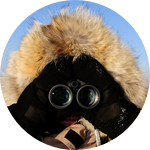About This Project
Moose (Alces americanus) and Eurasian elk (Alces alces) are the largest members of the family cervidae. The critical survival period for moose is winter because of a reduction of forage. During the winter months, deciduous trees have lost their leaves and moose are restricted to a diet of poor quality deciduous stems and evergreen needles. This project will examine foraging decisions of moose in the Greater Yellowstone Ecosystem.Ask the Scientists
Join The DiscussionWhat is the context of this research?
This project is part of a larger research project comparing moose foraging in three different ecosystems; Greater Yellowstone area, Isle Royale in Michigan and Evenstad, Norway. The purpose of three different ecosystems is to compare moose foraging choices in habitats with differing species of conifers (evergreens) and deciduous stems. I will examine moose diet through analysis of fecal scat (microhistology) in combination with field vegetative surveys and forage chemical analysis to determine foraging decisions of moose during winter. The field vegetative surveys will measure the forage available for moose within a certain habitat; the chemical analysis will measure the nutrients of the forage.
I hypothesize that moose winter foraging is in accordance with the nutrient balance hypothesis in an attempt to maximize crude protein, digestible energy and diet evenness while attempting to minimize crude fat and high cell wall content (CWC). The nutrient balance hypothesis states that animals will forage in order to consume a balance diet of nutrients.
Chemical analysis will determine the digestibility, crude fat, elemental composition (such as Calcium, Potassium, Sodium, etc), digestible energy, and the cell wall content of each type of forage. This will allow determination of dietary choices by comparing forage selected with chemical parameters.
What is the significance of this project?
Most research of foraging decisions of large mammalian herbivores concerns non-winter choices in plentiful habitats or controlled experiments. During winter, ungulate foraging decisions in the temperate forest are constrained to evergreen conifers and deciduous stems and bark. Few studies have compared winter diet composition to species availability within selected habitats and especially between habitats with low availability of desired forage.
A key concern for ecologists, wildlife managers and foresters is how consumed diet compares with spatial availability of forage in the unaltered natural environment. Using moose (Alces americanus), termed the model herbivore, I will examine winter foraging decisions. This study is related to the overall scientific mission because it promotes understanding of ecosystem-ungulate related stress interaction and furthers research and education of this important animal of worldwide northern distribution.
What are the goals of the project?
The results will be published in scientific journal articles. Furthermore, articles focused for the lay audience will be drafted for publication. Presentations will be made at the annual North American Moose Conference and to lay audiences interested in nature and the environment.
This research is part of a self-financed project that will consider the worldwide winter diet of moose. Moose in Europe and Asia consume deciduous stems and Scot's Pine; moose in North America consume a diet of either Balsam Fir/Northern White Cedar and deciduous stems or Subalpine Fir/Douglas Fir and deciduous stems. This project will look at the diet of moose within the Yellowstone Ecosystem which includes Yellowstone National Park, Grand Teton National Park and the surrounding communities.
By comparing moose winter foraging worldwide, wildlife managers, foresters and scientists will be better able to understand and manage moose.
Budget
A budget of $1500 will be used for travel expenses (gasoline) and food from Houghton, Michigan to Yellowstone. Field research within Yellowstone will be conducted during the month of April and the principal investigator will reside in a tent to conserve expenses.
The project is not supported by any government grants and the principal investigator is funding his own education and research. Therefore, every dime donated goes directly toward research with no overhead costs.
Lab Notes
Nothing posted yet.
Project Backers
- 5Backers
- 14%Funded
- $201Total Donations
- $45.00Average Donation
